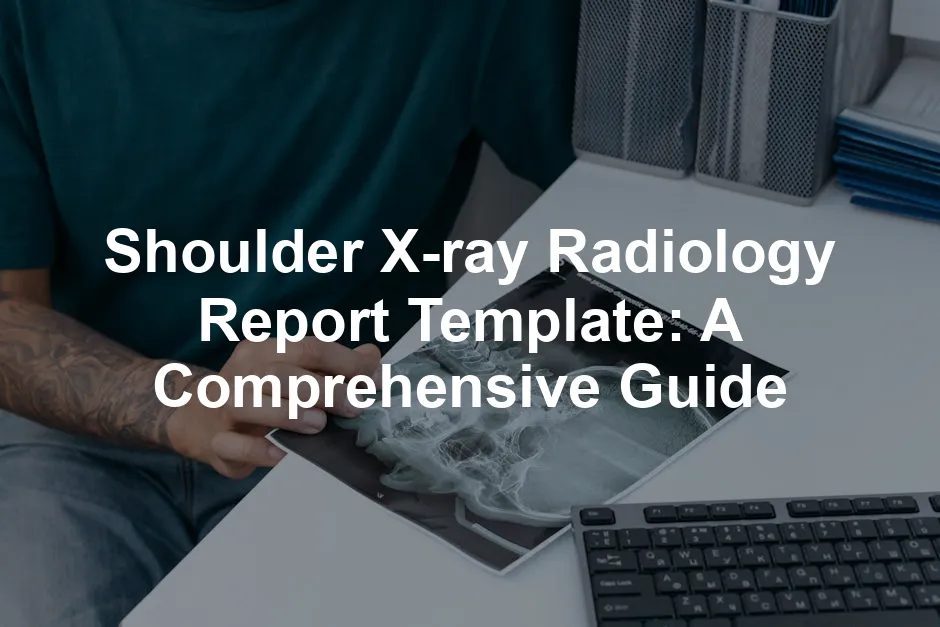Introduction
A structured radiology report template for shoulder X-rays is vital. It boosts efficiency and ensures consistency in clinical practice. This article aims to help radiologists create or use an effective shoulder X-ray radiology report template.
Summary and Overview
A shoulder X-ray radiology report template standardizes the reporting process. This is increasingly important in modern radiology, where clarity and precision matter. Using a structured template improves communication among medical professionals. It also enhances the accuracy of reported findings, leading to better patient outcomes.
Structured reporting fosters a common language. This reduces misunderstandings and misinterpretations of results. When radiologists and referring physicians share a clear format, clinical decision-making improves. Patients benefit from more precise diagnoses and targeted treatment plans. Overall, standardized reporting practices contribute significantly to enhanced patient care.

Importance of Using a Shoulder X-ray Radiology Report Template
Benefits of Structured Reporting
Structured reporting refers to a standardized format for medical reports. Unlike free-text reporting, structured reporting organizes information systematically. This organization enhances clarity and reduces confusion for all healthcare professionals involved.
Using a template improves communication between radiologists and referring physicians. When everyone uses the same format, understanding findings becomes straightforward. Important details are less likely to be overlooked.
Templates also save time. Radiologists can focus on analysis rather than formatting reports. This efficiency leads to consistency in reports, which is crucial for patient care.

If you’re looking to enhance your knowledge of medical terminology, consider grabbing a copy of Medical Terminology for Dummies. It’s a great resource to help you understand the language of the medical field, making your report writing process smoother and more professional.
Enhancing Diagnostic Accuracy
Templates significantly improve the completeness of reports. By including specific sections for findings, they ensure no critical information is missed.
Standardized language and terminology play a vital role in reducing ambiguity. When everyone uses the same terms, misunderstandings are minimized.
Studies have shown that structured reporting enhances diagnostic outcomes. For instance, a study found that structured reports received higher quality ratings than free-text ones. This indicates that using a template can lead to better clinical decision-making and improved patient care.
For more information on best practices in data visualization that can enhance your reporting, check out this article on best practices for using Israel Central Bureau of Statistics data visualization.

Key Components of a Shoulder X-ray Radiology Report Template
Patient Information
Every report starts with essential patient data. Include the patient’s name, age, and medical history. These details lay the foundation for accurate diagnosis and treatment. Accurate patient information ensures that the radiologist considers any pre-existing conditions affecting the shoulder. Misidentifying a patient can lead to serious consequences, so double-checking this section is crucial for patient safety.

Examination Details
This section outlines the specifics of the X-ray exam. Clearly state the modality, type of X-ray, and technique used. For example, note if the X-ray is anteroposterior or lateral. Use bullet points or a numbered list for clarity. A well-structured format helps healthcare professionals quickly understand the examination’s context, which aids in interpreting the findings accurately.
Findings
In the findings section, describe observations from the X-ray. Common elements to include are fractures, dislocations, or soft tissue conditions. Use straightforward language and avoid jargon to ensure readability. For instance, instead of saying “no significant abnormalities,” simply state, “no fractures or dislocations seen.” This clarity helps referring physicians grasp the situation quickly.

Impression
Summarize the key findings and provide a clinical impression here. This section is vital for guiding further patient management. Include recommendations for additional evaluations if needed. For example, you might suggest a follow-up MRI for further assessment. This concise summary helps clinicians make informed decisions about the patient’s care, enhancing their treatment plan.
Author Information
Documenting the author of the report is crucial. It establishes accountability and promotes professionalism. Including this information allows readers to identify who interpreted the X-ray findings.
Relevant credentials should be included to enhance credibility. This might involve the author’s name, title, and board certifications. Additional details like the institution or practice can also be beneficial. This transparency fosters trust between the radiologist and referring physicians.

Best Practices for Writing Effective Reports
Consistency in Formatting
Uniformity in report formatting matters. It enhances readability and allows quick navigation. A consistent layout helps all parties find critical information easily.
Examples of consistent layouts include standardized headings and bullet points. For instance, always using “Findings” followed by a list makes the report predictable. Clear distinctions between sections, such as “Impression” or “Recommendations,” also contribute to a clean, organized look.

To help with organizing your thoughts, a Medical Notepad for Doctors can be a lifesaver. It helps you jot down key findings and maintain that all-important consistency across reports.
Use of Standardized Terminology
Utilizing agreed-upon medical terminology is vital. Terms like those from RadLex provide clarity and reduce misunderstandings. When everyone speaks the same language, it improves collaboration among medical professionals.
Standardized terminology also enhances understanding among referring physicians. They can interpret findings more accurately, leading to better patient care. For example, using precise terms for anatomical structures and conditions ensures everyone is on the same page.

Incorporating Visuals
Including images or diagrams of shoulder X-rays can be highly beneficial. Visuals provide a quick reference that enhances understanding of the findings. They can clarify complex issues that may be difficult to convey through text alone.
For example, a labeled diagram of the shoulder joint can illustrate specific areas of concern. This aids communication, making it easier for referring doctors to grasp the situation quickly. Visuals can bridge gaps in understanding, improving overall patient management.

Additionally, consider using an Anatomy of the Shoulder: A Visual Guide. This resource offers fantastic visuals that can elevate your reporting game and help convey complex information with ease.
Challenges in Structured Reporting
Resistance to Change
Transitioning to structured reporting can be challenging. Radiologists often resist change due to comfort with existing practices. Common obstacles include fear of increased workload and doubts about the effectiveness of structured templates. To overcome this resistance, engage radiologists in discussions about the benefits of structured reporting. Highlight how these templates can actually save time in the long run. Implementing pilot programs can also help demonstrate their value. Creating a supportive environment encourages acceptance of standardized reporting practices.

Training and Adaptation
Training is essential for adapting to new reporting templates. Radiologists need to become familiar with the structured format to use it effectively. Offering workshops or online courses can be beneficial. Resources such as webinars or industry conferences provide valuable insights. Organizations can also create internal training sessions tailored to their specific needs. Encourage radiologists to seek out literature on structured reporting to enhance their skills. Familiarity with these templates will boost confidence and improve overall reporting quality.

As you embark on this journey, consider a Radiology: A Self-Assessment Companion. It’s a fantastic tool for brushing up on your skills while adapting to new reporting practices.
Conclusion
A shoulder X-ray radiology report template is crucial for efficiency and accuracy. It streamlines the reporting process, ensuring consistency across cases. By adopting structured reporting practices, radiologists can significantly enhance patient care and clinical outcomes. Embracing these templates not only benefits individual practices but also improves communication within the healthcare team. For implementation, numerous resources and templates are available online to assist radiologists in this transition. It’s time to make structured reporting a standard in radiology.

FAQs
What is a shoulder X-ray radiology report?
A shoulder X-ray radiology report summarizes findings from imaging studies. It aids in diagnosing and planning treatment for shoulder conditions.
Why should I use a shoulder X-ray report template?
Using a template ensures standardized and comprehensive reporting. This improves communication among healthcare providers, enhancing patient care.
How do I interpret findings in a shoulder X-ray report?
Understanding typical findings requires familiarity with shoulder anatomy and pathologies. Consulting radiologists can provide precise analyses of reports.
What are common findings in shoulder X-rays?
Common findings include fractures, dislocations, and soft tissue abnormalities. Recognizing these can guide appropriate treatment options.
Where can I find templates for shoulder X-ray reports?
Several websites offer downloadable templates or examples. Resources like RadReport.org and radiology associations are good starting points.
How can structured reporting improve patient outcomes?
Structured reporting enhances clinical decision-making by providing clear, concise information. This leads to more accurate diagnoses and better treatment plans.
What training resources are available for radiologists on structured reporting?
Radiologists can benefit from online courses, webinars, and literature on structured reporting techniques. Many professional organizations provide training to enhance these skills.
Please let us know what you think about our content by leaving a comment down below!
Thank you for reading till here 🙂
All images from Pexels




